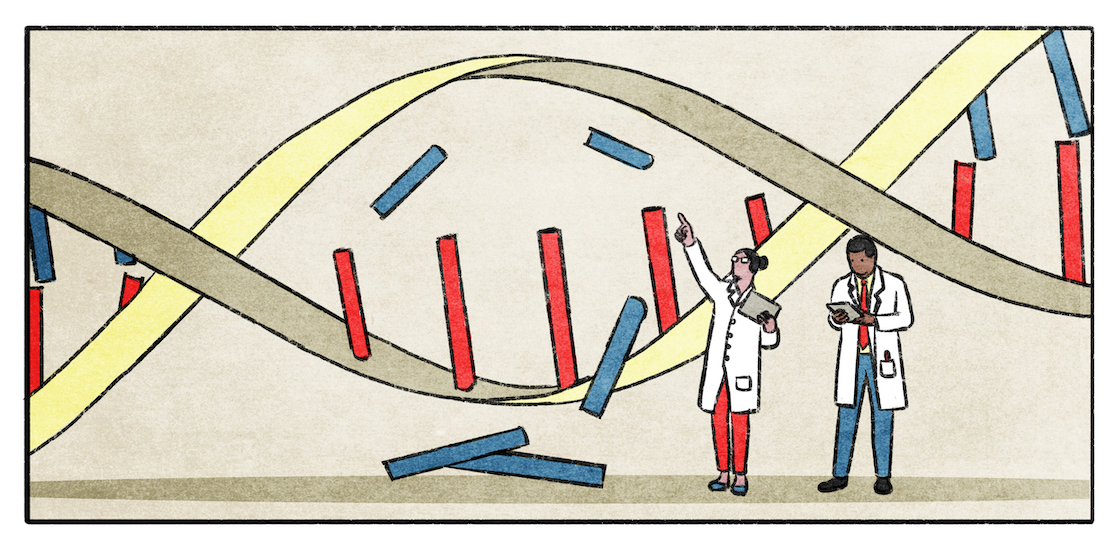The largest-yet analysis of whole-genome sequences from autistic people links new genes and variants to the condition. The findings and sequences — from 5,100 autistic and 6,212 non-autistic people — are on a cloud-based platform and are available to qualified researchers.
The effort is the latest advance from the ongoing MSSNG project and doubles the number of participants from the research collaboration’s prior release in 2017.
It also expands the types of variants considered, to include inherited or non-inherited, common or rare single-nucleotide variants; short insertions and deletions; structural variants; extra repeating bits of DNA called tandem repeat expansions; and mitochondrial DNA variants.
Collecting data on so many different types of variants at once is useful to a wide community of autism researchers — and required a wide range of expertise, says lead investigator Stephen Scherer, professor of molecular genetics at the University of Toronto in Canada. More than 100 researchers collaborated on this study for about two years.
“If you just took two authors randomly from that list and consider whether the first author would have been able to do what the second author did, and vice versa, in most cases the answer was no,” says Brett Trost, a postdoctoral researcher in Scherer’s lab.
Other autism geneticists eagerly awaited the latest MSSNG release, says Maria Chahrour, associate professor of neuroscience and human growth and development at the University of Texas Southwestern Medical Center in Dallas, who was not involved in the study. As of July, more than 300 researchers across 65 institutions and 20 countries had access to the database, according to the paper. The findings were published in Cell in November.
A
lmost 3,500 of the participants with autism are from simplex families, which have only one autistic child, and 777 are from multiplex families, which have at least two children on the spectrum. One-quarter of the participants are of non-European ancestry.Autism was strongly linked to 134 genes — 67 of them not previously reported — in an analysis of de novo coding variants in data from MSSNG plus two other projects: the Autism Sequencing Consortium and SPARK. (SPARK is funded by the Simons Foundation, Spectrum’s parent organization.) Many of the novel genes contribute to cellular functions implicated in autism, including synaptic signaling, chromatin remodeling and control of gene expression and protein translation.
Across the entire dataset, about 14 percent of autistic people carry rare variants. The team found a similar percentage among sequences from 9,205 people in the Simons Simplex Collection, a cohort of simplex autism families. (This collection is also funded by the Simons Foundation.)
“We’ve got a pretty good picture of rare genetic variation,” Scherer says. “Now’s the time to focus on what’s going on in the other 85 percent of families.” This will require studying hundreds of thousands of families’ entire genomes, he adds.
A
s a step in this direction, Scherer’s team calculated an autism polygenic risk score — a sum of common variants tied to the condition — for each MSSNG participant. Autistic people have higher scores than their non-autistic siblings do, the team found, which aligns with previous research. But autistic people from multiplex families do not have higher-than-average scores, suggesting that rare inherited variants play a stronger role in multiplex autism — a finding that complements an unpublished analysis of multiplex families presented at the American Society of Human Genetics conference in October.The new analysis of polygenic risk scores is a significant contribution, Chahrour says.
“I think it’s dangerous to hype up polygenic risk scores when we know so little, and when we’re relying mostly on European ancestry to calculate these scores,” says Chahrour, whose own genetics research focuses on ancestrally diverse cohorts.
The study also provided information to thousands of families that participated. Vicky Garbutt — who enrolled herself, her husband, their autistic son Jeffrey and their non-autistic son Luke — says she wanted to “give back” to researchers who have helped Jeffrey. And she was curious.
“We wanted to know if it was a genetic trait that we passed down to Jeff, and if that would have any relevance to his brother having children,” Garbutt says. “Knowledge is power.”
Jeffrey’s genome showed a spontaneous de novo genetic mutation that was not inherited from his parents.
“We knew that nothing was going to change,” Garbutt says, “but knowing that it was a ‘typo’ sort of gives us peace of mind.”






